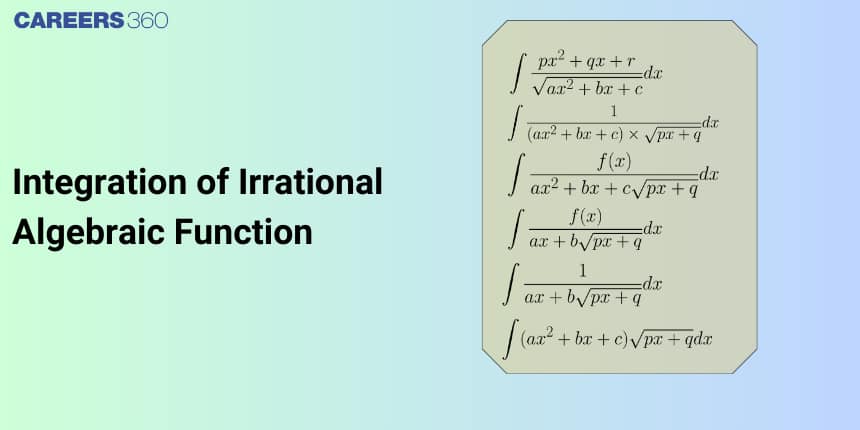Integration of Irrational Algebraic Function
Integration of Irrational Algebraic Function is one of the important parts of Calculus, which applies to measuring the change in the function at a certain point. Mathematically, it forms a powerful tool by which slopes of functions are determined, the maximum and minimum of functions found, and problems on motion, growth, and decay, to name a few. These integration concepts have been broadly applied in branches of mathematics, physics, engineering, economics, and biology.

In this article, we will cover the concept of Integration of Irrational Algebraic Functions. This concept falls under the broader category of Calculus, a crucial Chapter in class 12 Mathematics. It is not only essential for board exams but also for competitive exams like the Joint Entrance Examination (JEE Main), and other entrance exams such as SRMJEE, BITSAT, WBJEE, BCECE, and more. Over the last ten years of the JEE Main exam (from 2013 to 2023), four questions have been asked on this concept, including one in 2020, one in 2021, and two in 2022.
Integration of irrational functions
Integration is the reverse process of differentiation. In integration, we find the function whose differential coefficient is given. The rate of change of a quantity y concerning another quantity x is called the derivative or differential coefficient of y concerning x. Geometrically, the Differentiation of a function at a point represents the slope of the tangent to the graph of the function at that point.
Irrational Functions
An irrational equation is an equation where the variable is inside the radical or the variable is a base of power with fractional exponents. A function with one or more irrational equaitons are called irrational functions.
(a) Integrals of the Form
(i) $\int \frac{1}{(a x+b) \sqrt{p x+q}} d x$
(ii) $\int \frac{a x+b}{\sqrt{p x+q}} d x$
(iii) $\int \frac{\sqrt{p x+q}}{a x+b} d x$
(iv) $\int \frac{1}{\left(a x^2+b x+c\right) \sqrt{p x+q}} d x$
To evaluate this type of integrals, put $p x+q=t^2$
Evaluate: $\int \frac{d x}{(x+1) \sqrt{x+2}}$
Let $\mathrm{I}=\int \frac{d x}{(x+1) \sqrt{x+2}}$
Substitute: $x+2=t^2 \quad \Rightarrow \quad d x=2 t d t$
$
\begin{aligned}
& \Rightarrow \int \frac{d x}{x+1(\sqrt{x+2})}=\int \frac{2 t d t}{\left(t^2-1\right) \sqrt{t^2}}=2 \int \frac{d t}{t^2-1} \\
& =\frac{2}{2} \log \left|\frac{t-1}{t+1}\right|+C=\log \left|\frac{\sqrt{x+2}-1}{\sqrt{x+2+1}}\right|+C
\end{aligned}
$
(b) Integrals of the Form
(i) $\int \frac{1}{(p x+q) \sqrt{a x^2+b x+c}} d x$
To evaluate this type of integral, put $p x+q=1 /$ t
(c) Integrals of the Form
(i) $\int \frac{1}{\left(\mathrm{ax}^2+\mathrm{b}\right) \sqrt{\mathrm{px}^2+\mathrm{q}}} d \mathrm{x}$
To evaluate this type of integral, put $x=\frac{1}{t}$
Recommended Video Based on Integration of Irrational Functions
Solved Examples Based On Integration Of Irrational Functions
Example 1: Evaluate $\int \frac{d x}{(x-1) \sqrt{x^2+x+1}}, \mathrm{x}>1$.
$\begin{aligned}
& -\frac{1}{\sqrt{3}} \ln \left|\frac{1}{x-1}-\frac{1}{2}+\sqrt{\frac{12\left(\frac{1}{x-1}+\frac{1}{2}\right)^2+1}{12}}\right|+c \\
& \text { 2) } \frac{1}{\sqrt{3}} \ln \left|\frac{1}{x-1}-\frac{1}{2}+\sqrt{\frac{12\left(\frac{1}{x-1}+\frac{1}{2}\right)^2+1}{12}}\right|+c \\
& \frac{1}{\sqrt{3}} \ln \left|\frac{1}{x-1}+\frac{1}{2}+\sqrt{\frac{12\left(\frac{1}{x-1}+\frac{1}{2}\right)^2+1}{12}}\right|+c \\
& \text { 3) } \\
& \text { 4) }-\frac{1}{\sqrt{3}} \ln \left|\frac{1}{x-1}+\frac{1}{2}+\sqrt{\frac{12\left(\frac{1}{x-1}+\frac{1}{2}\right)^2+1}{12}}\right|+c
\end{aligned}$
Solution
As we learnt
The integration in the form
$\int_{\text {(i) }} \frac{d x}{(p x+q) \sqrt{a x^2+b x+c}}$
(ii) $\int \frac{d x}{(p x+q) \sqrt{a x+b}}$
$\int_{\text {(iii) }} \frac{(a+b x)^m}{(p+q x)^n} d x$
- wherein
Working rule.
$(\mathrm{i}) \rightarrow_{\text {put }}(p x+q)=\frac{1}{t}$
(ii) $\rightarrow$ put $(a x+b)=t^2$
(iii) $\rightarrow$ put $(p+q x)=t$
Put $\mathrm{x}-1=1 / \mathrm{t}$ and $d x=-1 / t^2 \mathrm{dt}$.
Invalid Equation
$=-\frac{1}{\sqrt{3}} \ln \left|(t+1 / 2)+\sqrt{\left(t+\frac{1}{2}\right)^2+\frac{1}{12}}\right|+c$
Invalid Equation
4) None of these
Example 2: $\int \frac{x}{(x-3) \sqrt{x+1}} d x$
1) $-2 \sqrt{x+1}-\frac{3}{2} \ln \left|\frac{\sqrt{x+1}-2}{\sqrt{x+1}+2}\right|+c$
2) $2 \sqrt{x+1}-\frac{3}{2} \ln \left|\frac{\sqrt{x+1}-2}{\sqrt{x+1}+2}\right|+c$
3) $2 \sqrt{x+1}+\frac{3}{2} \ln \left|\frac{\sqrt{x+1}-2}{\sqrt{x+1}+2}\right|+c$Solution
Solution
As we learned
The working rule is
put $(a x+b)=t^2$
Put $x+1=t^2$. We get
$\begin{aligned}
& \int \frac{x}{(x-3) \sqrt{x+1}} d x \\
& \int \frac{x-3+3}{(x-3) \sqrt{x+1}} d x=\int \frac{x-3}{(x-3) \sqrt{x+1}} d x+3 \int \frac{1}{(x-3) \sqrt{x+1}} d x \\
& \int \frac{1}{\sqrt{x+1}} d x+3 \int \frac{1}{(x-3) \sqrt{x+1}} d x \\
& \int \frac{1}{\sqrt{x+1}} d x=2 \sqrt{x+1} \\
& (\text { put } x+1=t) \\
& 3 \int \frac{1}{(x-3) \sqrt{x+1}} d x=-\frac{3 \ln (\sqrt{x+1}+2)}{2}+\frac{3 \ln (\sqrt{x+1}-2)}{2} \\
& \left(\text { put } x+1=t^2\right) \\
& =-\frac{3 \ln (\sqrt{x+1}+2)}{2}+\frac{3 \ln (\sqrt{x+1}-2)}{2}+2 \sqrt{x+1} \\
& =2 \sqrt{x+1}+\frac{3}{2}\left(\log \frac{\sqrt{x+1}-2}{\sqrt{x+1}+2}\right)+c
\end{aligned}$
Hence, the answer is the option 3.
Example 3: $\int \frac{d x}{(2 x+3) \sqrt{4 x+5}}=$
1) $\tan ^{-1} \sqrt{4 x-5}+c$
2) $4 \tan ^{-1} \sqrt{4 x+5}+c$
3) $\tan ^{-1} \sqrt{5 x+4}+c$
4) $\tan ^{-1} \sqrt{5 x-4}+c$
Solution
Let $I=\int \frac{d x}{(2 x+3) \sqrt{4 x+5}}$
Put $4 \mathrm{x}+5=\mathrm{t}^2$
$\therefore x=\frac{t^2-5}{4}$
and
$\begin{aligned}
& d x=2 t \cdot d t \\
& \therefore I=\int \frac{2 t \cdot d t}{\left(2\left(\frac{t^2-5}{4}\right)+3\right) \cdot t} \\
& \therefore I=\int \frac{4 d t}{\left(t^2+1\right)} \\
& \therefore I=4 \tan ^{-1}(t)+c \\
& \therefore I=4 \tan ^{-1} \sqrt{4 x+5}+c
\end{aligned}$
Hence, the answer is the option 2.
Example 4: The integral $\int \frac{1}{\sqrt[4]{(x-1)^3(x+2)^5}} \mathrm{~d} x$ is equal to : (where $C$ is a constant of integration)
1) $\frac{3}{4}\left(\frac{x+2}{x-1}\right)^{\frac{5}{4}}+C$
2) $\frac{4}{3}\left(\frac{x-1}{x+2}\right)^{\frac{1}{4}}+C$
3) $\frac{4}{3}\left(\frac{x-1}{x+2}\right)^{\frac{5}{4}}+C$
4) $\frac{3}{4}\left(\frac{x+2}{x-1}\right)^{\frac{1}{4}}+C$
Solution
$\begin{gathered}
I=\int \frac{1}{(x-1)^{\frac{3}{4}}(x+2)^{\frac{5}{4}}} d x \\
I=\int \frac{1}{(x-1)^2\left(\frac{x+2}{x-1}\right)^{\frac{3}{4}}} d x
\end{gathered}$
Let $\frac{x+2}{x-1}=t \Rightarrow \frac{(x-1)-(x+2)}{(x-1)^2} d x=d t$
$\begin{aligned}
& \Rightarrow I=\frac{-1}{3} \int \frac{d t}{t^{\frac{5}{4}}}=\frac{-1}{3} \times \frac{t^{\frac{-5}{4}+1}}{-\frac{5}{4}+1}+c=\frac{4}{3} t^{\frac{-1}{4}}+c \\
& =\frac{4}{3} \times\left(\frac{x-1}{x+2}\right)^{\frac{1}{4}}+c
\end{aligned}$
option (2)
Example 5: Let $I(x)=\int \sqrt{\frac{x+7}{x}} d x$ and $I(9)=12+7 \log _e 7$. If $I(1)=\alpha+7 \log _e(1+$ Example $5: 2 \sqrt{2}$ ), then $\alpha^4$ is equal to
1) $64$
2) $23$
3) $43$
4) $21$
Solution
$\begin{aligned}
& \int \sqrt{\frac{x+7}{x}} d x \\
& \text { Put } x=t^2 \\
& \mathrm{dx}=2 \mathrm{tdt} \\
& \int 2 \sqrt{\mathrm{t}^2+7} \mathrm{dt}=2 \int \sqrt{\mathrm{t}^2+\sqrt{7^2}} \mathrm{dt} \\
& \mathrm{I}(\mathrm{t})=2\left[\frac{\mathrm{t}}{2} \sqrt{\mathrm{t}^2+7}+\frac{7}{2} \ln \left|\sqrt{\mathrm{t}^2+7}\right|\right]+\mathrm{C} \\
& \mathrm{I}(\mathrm{x})=\sqrt{\mathrm{x}} \sqrt{\mathrm{x}+7}+7 \ln |\sqrt{\mathrm{x}}+\sqrt{\mathrm{x}+7}|+\mathrm{C} \\
& \mathrm{I}(9)=12+7 \ln 7=12+7(\ln (3+4))+\mathrm{C} \\
& \Rightarrow \mathrm{C}=0 \\
& \mathrm{I}(\mathrm{x})=\sqrt{\mathrm{x}} \sqrt{\mathrm{x}+7}+7 \ln (\sqrt{\mathrm{x}}+\sqrt{\mathrm{x}+7}) \\
& \mathrm{I}(1)=1 \sqrt{8}+7 \ln (1+\sqrt{8}) \\
& \mathrm{I}(1)=\sqrt{8}+7 \ln (1+2 \sqrt{2}) \\
& \alpha=\sqrt{8} \\
& \alpha^4=\left(8^{1 / 2}\right)^4 \\
& \alpha^4=8^2=64
\end{aligned}$
Hence, the answer is (64).